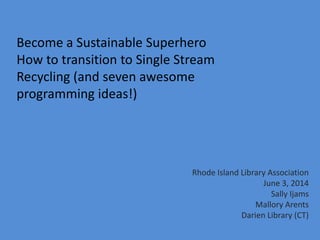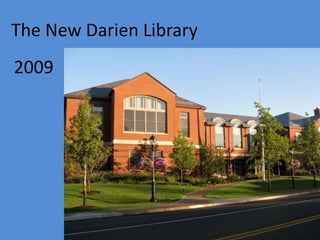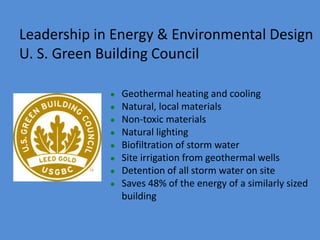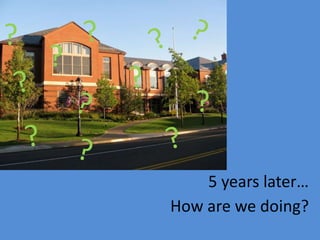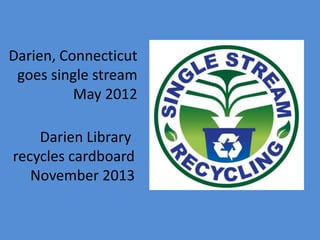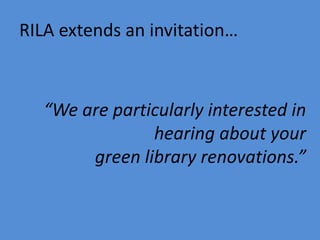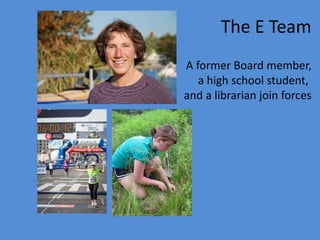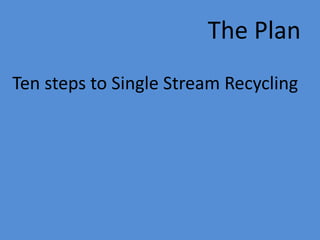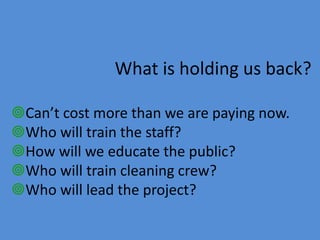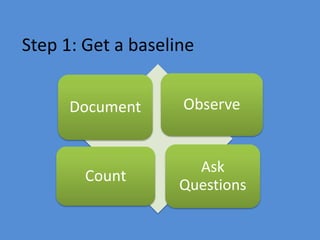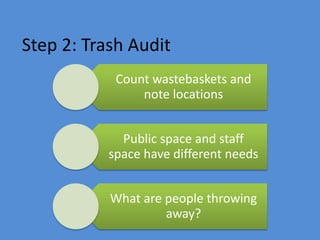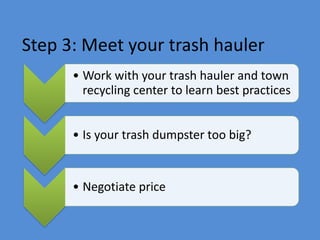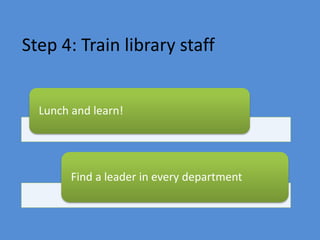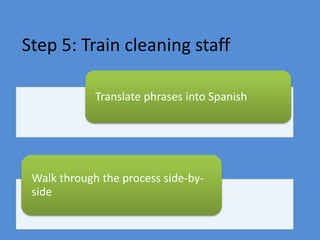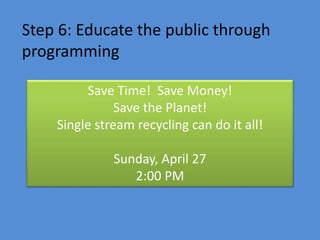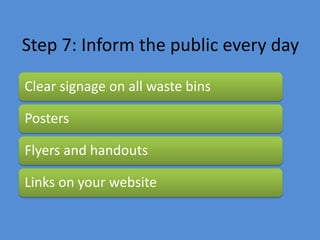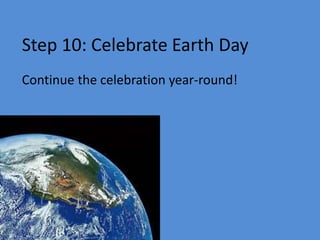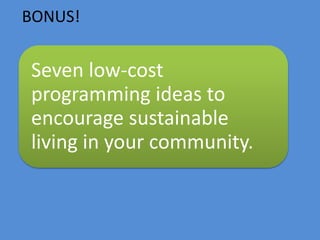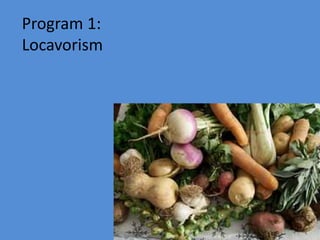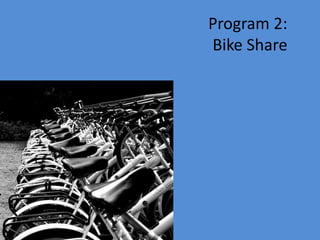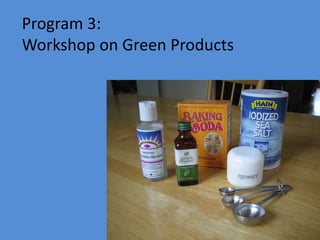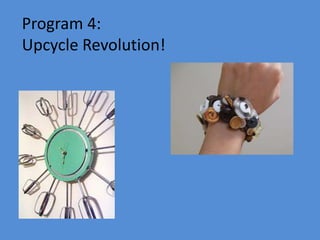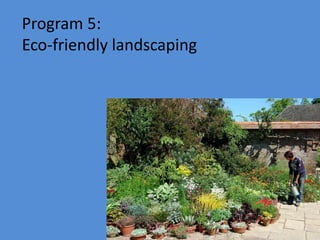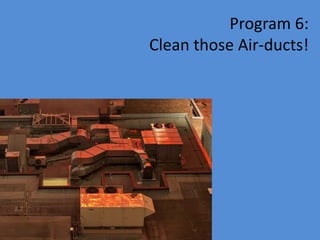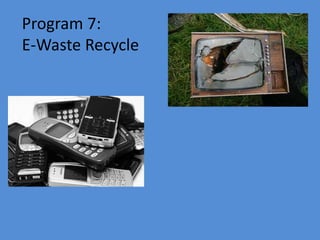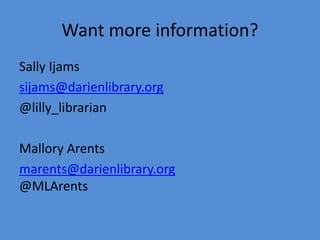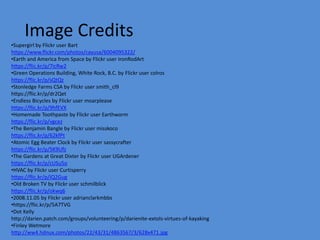RILA 2014
- 1. Become a Sustainable Superhero How to transition to Single Stream Recycling (and seven awesome programming ideas!) Rhode Island Library Association June 3, 2014 Sally Ijams Mallory Arents Darien Library (CT)
- 2. 2009 The New Darien Library
- 3. ï Geothermal heating and cooling ï Natural, local materials ï Non-toxic materials ï Natural lighting ï Biofiltration of storm water ï Site irrigation from geothermal wells ï Detention of all storm water on site ï Saves 48% of the energy of a similarly sized building Leadership in Energy & Environmental Design U. S. Green Building Council
- 4. 5 years laterâĶ How are we doing? ? ? ?
- 5. Darien Library recycles cardboard November 2013 Darien, Connecticut goes single stream May 2012
- 6. RILA extends an invitationâĶ âWe are particularly interested in hearing about your green library renovations.â
- 7. A former Board member, a high school student, and a librarian join forces The E Team
- 8. Ten steps to Single Stream Recycling The Plan
- 9. ïĨCanât cost more than we are paying now. ïĨWho will train the staff? ïĨHow will we educate the public? ïĨWho will train cleaning crew? ïĨWho will lead the project? What is holding us back?
- 10. Step 1: Get a baseline Document Observe Count Ask Questions
- 11. Step 2: Trash Audit Count wastebaskets and note locations Public space and staff space have different needs What are people throwing away?
- 12. Step 3: Meet your trash hauler âĒ Work with your trash hauler and town recycling center to learn best practices âĒ Is your trash dumpster too big? âĒ Negotiate price
- 13. Step 4: Train library staff Lunch and learn! Find a leader in every department
- 14. Step 5: Train cleaning staff Translate phrases into Spanish Walk through the process side-by- side
- 15. Step 6: Educate the public through programming Save Time! Save Money! Save the Planet! Single stream recycling can do it all! Sunday, April 27 2:00 PM
- 16. Step 7: Inform the public every day Clear signage on all waste bins Posters Flyers and handouts Links on your website
- 17. Step 8: Highlight Green features in your library If youâve got it, flaunt it
- 18. Step 9: Spread the word Break down your process into simple steps that can be used by other local businesses and public places.
- 19. Step 10: Celebrate Earth Day Continue the celebration year-round!
- 20. BONUS! Seven low-cost programming ideas to encourage sustainable living in your community.
- 23. Program 3: Workshop on Green Products
- 26. Program 6: Clean those Air-ducts!
- 28. Want more information? Sally Ijams sijams@darienlibrary.org @lilly_librarian Mallory Arents marents@darienlibrary.org @MLArents
- 29. Image Credits âĒSupergirl by Flickr user Bart https://www.flickr.com/photos/cayusa/6004095322/ âĒEarth and America from Space by Flickr user IronRodArt https://flic.kr/p/7icRw2 âĒGreen Operations Building, White Rock, B.C. by Flickr user colros https://flic.kr/p/sQtQz âĒStonledge Farms CSA by Flickr user smith_cl9 https://flic.kr/p/dr2Qet âĒEndless Bicycles by Flickr user moarplease https://flic.kr/p/9hfEVX âĒHomemade Toothpaste by Flickr user Earthworm https://flic.kr/p/vgcez âĒThe Benjamin Bangle by Flickr user misskoco https://flic.kr/p/62kfPt âĒAtomic Egg Beater Clock by Flickr user sassycrafter https://flic.kr/p/5K9Ufz âĒThe Gardens at Great Dixter by Flickr user UGArdener https://flic.kr/p/cUSu5o âĒHVAC by Flickr user Curtisperry https://flic.kr/p/iQ2Gug âĒOld Broken TV by Flickr user schmilblick https://flic.kr/p/okwq6 âĒ2008.11.05 by Flickr user adrianclarkmbbs âĒhttps://flic.kr/p/5A7TVG âĒDot Kelly http://darien.patch.com/groups/volunteering/p/darienite-extols-virtues-of-kayaking âĒFinley Wetmore http://ww4.hdnux.com/photos/22/43/31/4863567/3/628x471.jpg
Editor's Notes
- #11: Document: How much are you paying for monthly hauling fees? How much garbage do you currently generate? Observe: What are people throwing in trash versus recycling bins? How long does it take the cleaning service to empty the wastebaskets every night? Count: Exactly how many wastebaskets are in the building? Ask questions: How does the entire process work now?
- #12: Darien had over 80 wastebaskets and recycling bins- each emptied every night. Discovered that the cleaning staff put EVERYTHING except cardboard in the garbage, regardless of receptacle. People put everything associated with lunch in the garbage, even if almost everything could be recycled.
- #13: Took a tour of our local recycling centerâ most people still know it as the Dump! We were able to move from a 4-yard garbage dumpster to a 3-yard size for recycling and 3 âtoterâ bins for garbage. Immediate projected savings of 15%.
- #14: Tech bites Provided lunch from Panera and then demonstrated where each item should go. Collected misc items from office trash for examples. Answered questions specific to libraries: Can RFID tags be recycled? Damaged books? Pizza boxes?
- #15: Met with the owners of the company and discussed the plan. They are now using us as the example for other buildings they service! Created a list of common concepts and terms and translated them into Spanish. Walked through the cleaning process the first two nights, explaining the changes. Cleaning people are much happier! They spend less time with trashbags, can spend more time cleaning other areas.
- #16: Coincided with Earth Day week
- #17: Big signs, easy to read. Test run for signs and decals that the Town will produce. We didnât create our own material, used what the Town developed. Will have links to all checklists, flyers, good websites
- #19: Checklists!
- #27: Dust, debris, and other particles can collect in ventilation systems making your library less energy efficient. Ėý A thorough, once-a-year cleaning from your local HVAC expert will save in electricity, gas, and money. Ėý Bonus: patron with seasonal allergies will thank you!
- #28: Offer a space for patrons to properly recycle used TVs, broken laptops, old cellphones, and batteries. Ėý These items often fill-up landfills and can be extremely harmful to the environment.

